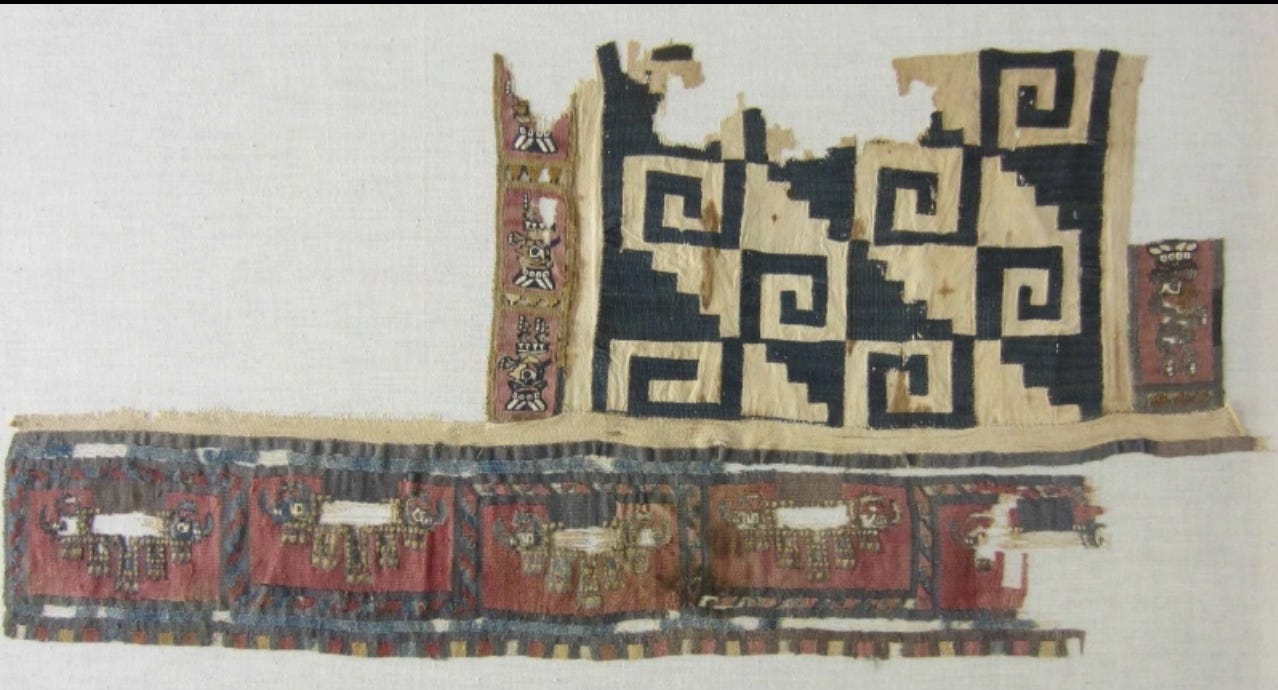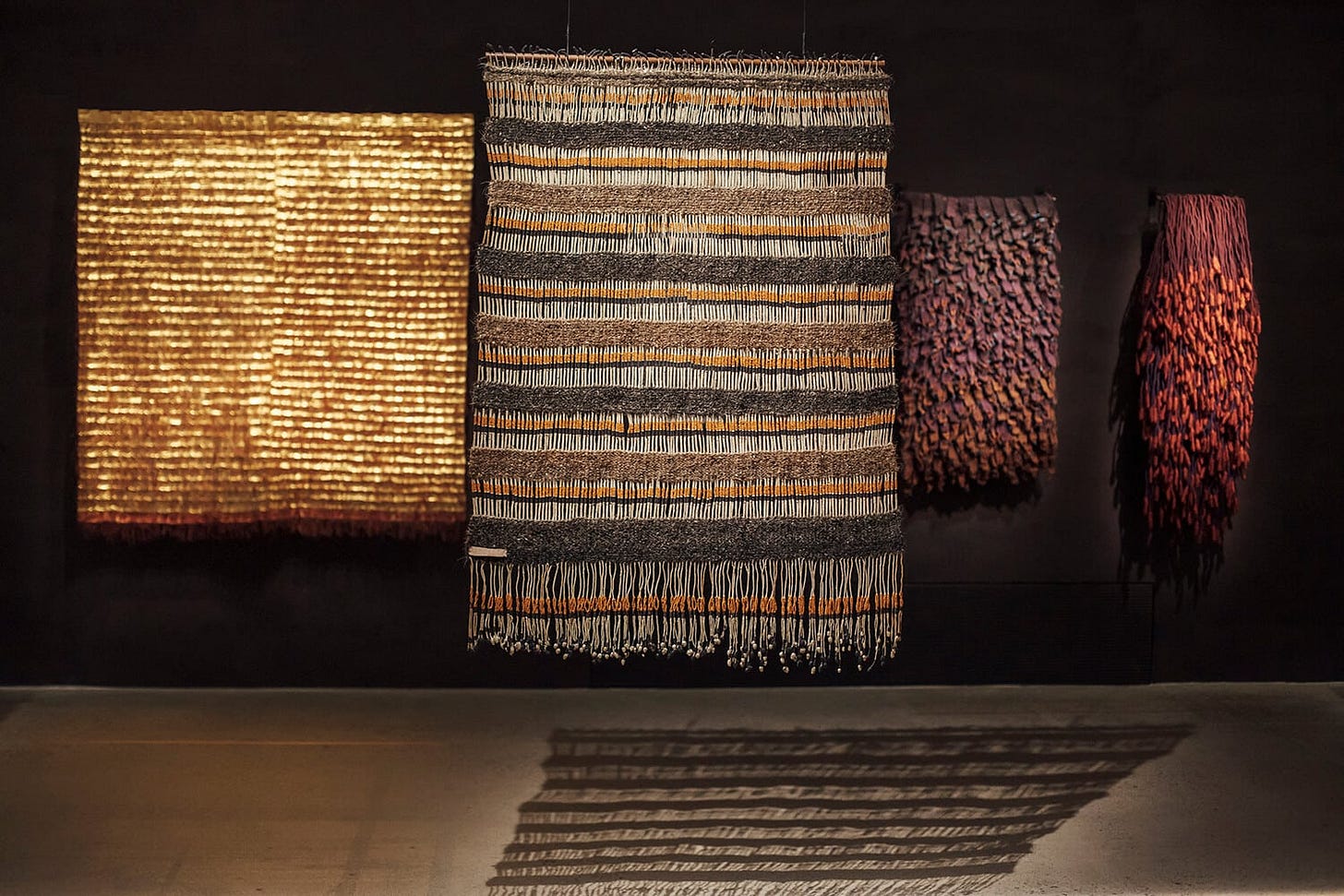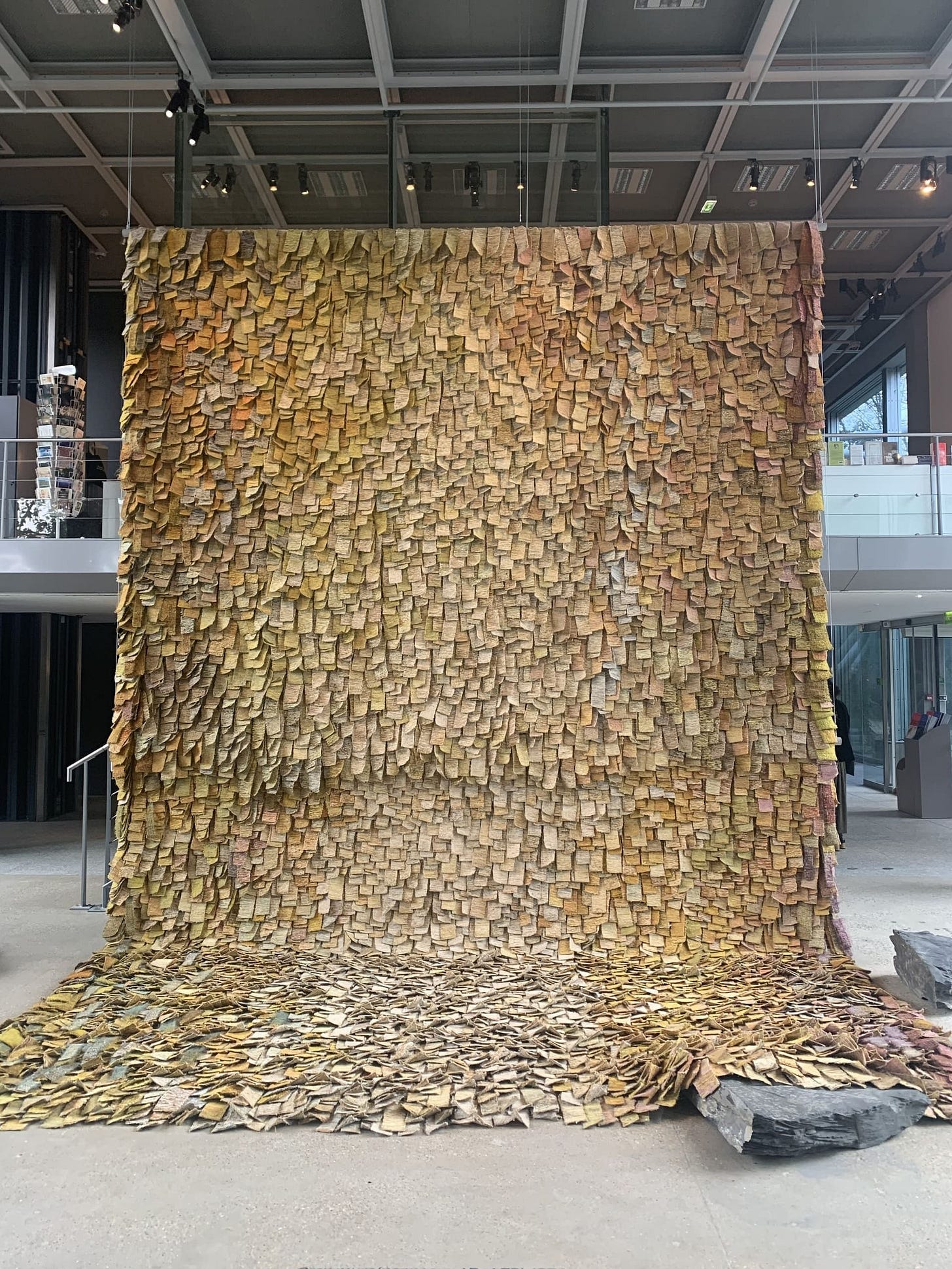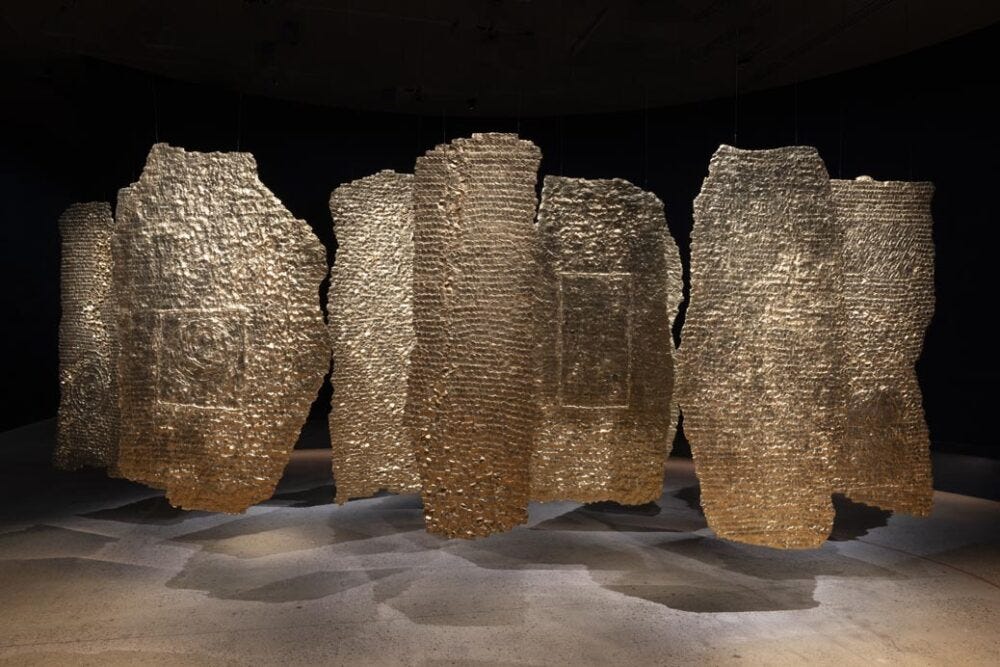Olga de Amaral creates color and space; she weaves them into form. She builds a language of her own, communicating between the cosmos and the terrestrial to encode infinity in a single knot. Through her work, Amaral revives ancestral codes, speaking the language of thread, expanding it.
Olga de Amaral is honored with a retrospective at the Fondation Cartier in Paris, marking their 40th anniversary, on view until March 16, 2025. As a Colombian, I can't help but feel a deep, irrational pride for this milestone. It feels like reclaiming culture in a quiet act of reconnection. This exhibition is about ancestral knowledge entwined with undeniable artistic mastery. It doesn't deny any historical framework, but incorporates new ones, crafting a counter-narrative that holds space and resists erasure.
Olga de Amaral was born in 1932 in Bogotá, Colombia. After earning a degree in architecture at the Colegio Mayor de Cundinamarca (1951–1952), she pursued her studies at the Cranbrook Academy of Art in Michigan (1954–1955), an institution often likened to Germany’s Bauhaus for its integration of art and craft. Amaral embraced innovative materials and techniques, blending Modernist principles with Colombian traditions.
The press release situates Amaral as a pivotal figure in both Colombian contemporary art and the fiber art movement, a movement currently gaining momentum. With major exhibitions like “Unravel – The Power and Politics of Textiles in Art” at the Stedelijk Museum, the itinerant exhibition “Woven Histories: Textiles and Modern Abstraction” opening at MOMa in 2025, and significant nods at the Venice Biennale, fiber art is, in a sense, in vogue.
Perhaps this retrospective aligns with this zeitgeist, folding Amaral’s work into a broader narrative of global art trends. But what lies beneath this timing and framing?
The influence of Andean textiles on Western modernism—seen in movements like Cubism, Constructivism, Abstraction, Minimalism, and of course Fiber art—manifests in the use of geometric patterns, vivid color palettes, and spatial compositions. To revisit these textiles today is to recognize their rightful place not as peripheral to modernism, but as foundational to its evolution and history.
(New) Modernisms
By the late 19th century, Berlin housed the largest collection of Andean textiles outside Peru. In 1875, German archaeologists excavated the necropolis of Ancón, unearthing remarkably preserved textiles dating back to the 6th century. These artifacts, displayed in the Museum für Völkerkunde, were seen by leading modernist figures like Anni Albers, Paul Klee, Franz Marc, and the Blue Rider artists; encounters that somehow must have been instrumental in shaping modernist abstraction, connecting it to a lineage entrenched not only in innovation but in Ancestral traditions.
By then the ideals of unrelenting progress through industrial development faced critique contesting the belief that reality could be objectively understood, particularly after the traumas of two world wars. Western societies, shaken and disoriented, began looking outward, beyond their own paradigms, in search of alternative structures to comprehend a fractured world. In seeking new answers, artists forged paths through lesser-traveled roads.
Modernist institutions such as the Bauhaus, turned their attention to overlooked techniques and traditions, such as handcrafted objects and textiles of non-Western societies. These practices, with their craftsmanship and cultural specificity, resonated with their ideal of integrating art into everyday life, offering a counterpoint to alienation with a vision of a more harmonious, human-centered modernity.
In the 1930s, Bauhaus pioneers Josef and Anni Albers traveled to Mexico, immersing themselves in the cultural heritage of the region, learning about Indigenous traditions and Andean weaving techniques. During these voyages, they saw artisans using the portable backstrap loom. This Andean technique, requiring the weaver to tension the warp with their own body, anchoring it to a tree or post, was later introduced to their students at Black Mountain College, influencing figures like Sheila Hicks.

From the early 1960s to the late 1970s, fiber art had already etched a distinct chapter in art history, championed predominantly by women across Europe and the United States exploring the sculptural and three-dimensional value of thread and fabric. You have Magdalena Abakanowicz’s monumental Abakans; Lenore Tawney’s sculptural cathedrals with thread; and Sheila Hicks, who spent decades learning from artisans from Mexico to Morocco, turning thread and fiber into whatever her mind was capable of imaging. And you have also of course, Cecilia Vicuña and Olga de Amaral, who have carved their place as Latin American artists within this movement—Vicuña with her monumental Quipus, which earned her the Golden Lion at the 2022 Venice Biennale, and Amaral as the masterful "rock weaver.”
Even within a movement so profoundly rooted in Amerindian traditions, only a handful of Latin American artists have been recognized in the broader historical narrative. Latin American art tied to non-western legacies has often been sidelined, confined to the periphery, and too frequently relegated to the category of craft. This glaring contradiction prompts a necessary reevaluation, urging us to question the foundations of modernism and its entanglements with histories that have been overshadowed and systematically suppressed.
Fiber art, so often confined to the bounds of modern categorization, is far more than a craft: it is a system of knowledge; an ancestral practice. Long before the advent of written language, Amerindian and Mesoamerican civilizations encoded complex ideas through thread, constructing a language that spoke through material and form. By the early Nazca period, weaving techniques that still inform contemporary practices had already reached extraordinary levels of sophistication. In these societies, weaving was not just a craft but a mode of thought, an accounting system, and an instrument of social order. It transcended functionality, embodying both abstraction and the abstracted; a language unto itself.
Olga de Amaral’s work exists within this broader trajectory, where art serves as a lens to renegotiate modernity itself.
Shaped by her architectural training and refined at Cranbrook Academy, Amaral’s work blends the structured modernism of her education with the ancestral language of the Andes and pre-Columbian heritage. The result is a practice that withstands classification, fabricating art and craft into something entirely of its own.
The Fondation Cartier exhibition offers a rare, comprehensive view of her accomplished work, against the reductiveness of chronological curation. It emphasizes her relentless experimentation with materials, scale, and form while tracing the diverse influences that inform her practice.
The exhibition space unfolds in three sections, with one of the main rooms dedicated to works evoking landscapes and cartographies. These towering, large-scale pieces hang from the ceiling like colossal mountains or urban edifices. If you’ve ever walked through Bogotá or Medellín, you’ll recognize echoes of their architecture: brick buildings that blanket the cities in terracotta hues, reminiscent of Muro en Rojo (1982) or Gran Muro (1976). Crafted from cotton, wool, and horsehair, these works exceed the flatness of the textile, embracing a three-dimensionality that pervades the space with a sense of magical realism. Walking through this room feels like wandering an enchanted forest outside time, where nature and architecture collide in a boundless explosion of color and form.

Adjacent to this, the surreal atmosphere continues with works of an entirely different nature. Here, the tapestry unravels—deconstructed into air, into Brumas. Shapes dissolve and reconfigure, morphing into ethereal traces of light and shadow that drift with the viewer’s movement. These are living artworks, ever-changing and hypnotic, designed to be walked through and experienced. Cotton threads suspended in midair form dense, cloud-like geometries, creating a state of suspended disorientation. Like mist, the threads obscure vision and redefine the room’s space, conjuring an atmosphere that is as much about absence as it is about presence; a meditative, shape-shifting interplay of light, color, and movement.

Downstairs, a room brimming with suspended works offers a force of weight and heaviness; almost noise-canceling. The tapestries have abandoned the floor, occupying the air, building a dialogue with space itself organized around thematic currents that have shaped Olga de Amaral’s pursuit of light and language.
The exhibition culminates in Estelas, a spiraled, cocoon-like space centered around 13 gold-leafed works. This room evokes the spiritual, channeling the profound significance gold held for pre-Colombian societies, but also the material’s inherent magnificence: its closeness to the sun, its reflective power, its omnipresence, and its radiant sheen. It is a mystical landscape absorbed with sacred resonance. Amaral captures the essence of megaliths by speaking the hidden language of stones and structuring their silent testimony: “They are the links that connect the earth to the heavens. Captive in the silence of the stone, there is an answer.” This final room is less an end and more an ascension, a transcendence into the cosmos, a glimpse of something bigger than ourselves.
Amaral’s process indulges traditional means and materials: she experiments with plastic, linen, horsehair, gesso, and gold with techniques of weaving, knotting, and braiding. Amaral was steeped in a cultural landscape where weaving is inseparable from the colors and forms of daily life. Her art does not merely continue this tradition; it transforms it.
The importance of this exhibition at the Fondation Cartier lies in its quiet but heartfelt acknowledgment. There is still so much to uncover, and so many voices to amplify; It opens a door to other ways of seeing, honoring perspectives that have long been sidelined. I know people are getting tired of these narratives, but some of us really need them. In parallel, the social sciences and humanities are also increasingly revisiting the past, to dissect it through contemporary lenses. This reverse engineering of time seeks to uncover how present-day phenomena are implanted in specific actions, places, and historical contexts. It is a way of understanding not just how we came to be, but how histories, constructed and contested, continue to shape our identities and futures.
Much of what Olga de Amaral has achieved with her practice circles back to the essence of her being—her landscape, her relentless pursuit of light and color; an exploration of the tactile and the imaginary. While her work undeniably carries modernist influences, it elevates the traditions in her techniques, with unparalleled refinement.
Her art is a testament to heritage, a bridge between the ancestral and the contemporary. It inspires an almost ineffable pride and hope, as this knowledge find its rightful place in the narrative of contemporary art and a broader history of influences. Amaral’s work anchors the past in the present and carries it forward with profound resonance.
This dispatch is part of a series from Las Ligas Menores, Editorial 1: Weaving Voices Untranslated.








